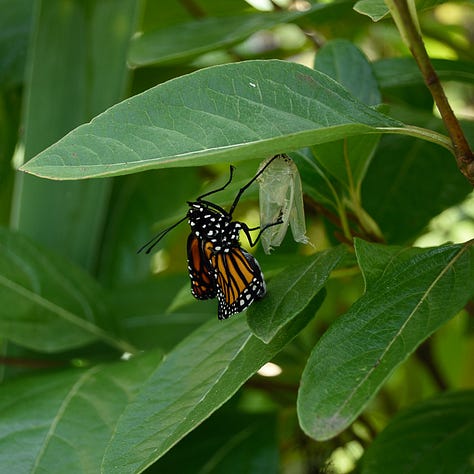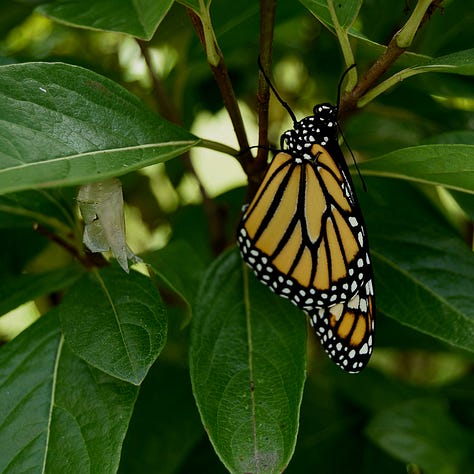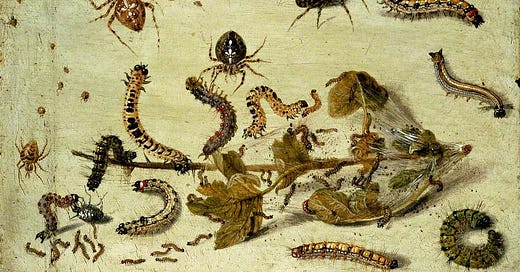In one of those moods that everyone falls into sometimes, when the world of the imagination suffers a winter that blights its vegetation; when the light of life seems to go out and existence becomes a barren desert where we wander, exposed to all the tempests that blow under heaven, without hope of rest or shelter—in one of these black humours, I was walking one evening at the edge of a forest.
This is how twenty-four-year-old Emily Jane Brontë began her devoir, The Butterfly. The essay is usually included in annotated editions of Wuthering Heights and critics and scholars have used if for decades to attempt to understand Emily Jane.
Sue Lonoff, in her examination of Charlotte and Emily Brontë’s Belgian essays, notes:1
Whatever clues “The Butterfly” may provide about the author’s mind and art, its formal tensions anticipate those of Wuthering Heights, as do such reflections as those concerning the “principle of destruction in nature…”
Over the weekend I read a number of essays, in which authors and artists discuss why we continue pursuing Our Work, and why especially, in this uncertain world? In Emily Jane’s essay she ponders why a caterpillar injures the very plant which protects it and why we (humans) celebrate our births, into a world such as this one?
Why was [the caterpillar] created, and why was man created? He torments, he kills, he devours; he suffers, dies, is devoured—there you have his whole story.
Oh, Emily. Indeed. All living things—plants, animals, fungi— we torment, kill, devour and we are tormented, devoured and in the end, simply perish. That journey, though…the experience of living is what authors and artists, continue to explore and record.
We create evidence of our experiences. Our private diaries and public art, record the same things: life lived. As only we live it. We don’t necessarily concern ourselves with whether or not Others understand our method of record-keeping, do we? It is not for them. Our Work is for us.
Years ago I watched a monarch devour the common milkweed I grow in my meadow garden. Day-after-day the caterpillar chewed. If the caterpillar met with aphids, the aphids (along with the leaf material) were eaten too. I learned to recognize frass (or, caterpillar excrement), and using evidence of the droppings I now can find a yellow, black and white striped larva anywhere on a plant. Until one day, I cannot.
A monarch caterpillar eventually stops eating. It grows from a tiny little speck on the underside of a milkweed leaf to a fat, worm-like, smooth caterpillar boasting adorable squiggly-looking sensory organs on its head; they look like antennae.
The monarch, not giving a tuppenny button if I know where it is going, sets off on a walk-about of our property. Eventually, it finds a secure place on which to suspend itself, it tucks its head into a J-formation, splits its skin and the caterpillar violently spins itself into an absolutely remarkable glistening jewel: the monarch chrysalis.
The first time I witnessed this I was in absolute awe. Truth-be-told, it still thrills me!
How could something which only days ago looked like a colorful, fat, striped worm have this gem inside of it? And then, to make the transformation more extraordinary, this bauble becomes transparent and through it, we see the orange and black butterfly yet-to-emerge. The chrysalis wiggles and sways, splits and opens and the caterpillar, now transformed into the familiar butterfly, is released.



Monarch caterpillars are charming. Their chrysalides are quite breathtaking! And the striking orange and black butterflies are beautiful. Not all caterpillars are lovely. And, Emily Jane was correct: they may destroy their host plants.
Gregarious gipsy moth caterpillars feed on more than 300 different trees and shrubs. If the caterpillars repeatedly defoliate the same specimen, season-after-season, those trees will eventually die. Emily Jane couldn’t help but critique this phenomenon.
Every being must be the tireless instrument of death to others, or itself must cease to live, yet nonetheless we celebrate the day of our birth, and we praise God for having entered such a world.
In Wuthering Heights, the gipsy Heathcliff is the tireless instrument of death to others, or so it seems. While he is never directly responsible for anyone’s death, destruction is near total by the time he, himself, ceases to live. Perhaps this is to what Lonoff refers?
Emily Jane paid attention to Nature. She recognized everything is connected. And her father’s faith taught her there is a transcendental dimension to life. Edward Chitham, in A Life of Emily Brontë (1987) goes so far as to call Brontë a nihilist.2
All creation is equally mad. Behold those flies playing above the brook; the swallows and fish diminish their number every minute. These will become in their turn, the prey of some tyrant of the air or water; and man for his amusement or his needs will kill their murderers.
Flies lay eggs in my garden pond. Some are swallowed by my fantail goldfish as larvae, others mature and leave the water, only to be snatched by a songbird to feed its young. The songbird may be killed by a feral cat. And, for what? Perpetuation of life.
Emily Jane Brontë had not yet begun writing Wuthering Heights when she penned The Butterfly. And likely, she never saw a monarch chrysalis. She wondered why the worm, the caterpillar, injures the very plant which protects it. Maybe in the case of the gipsy moth (and the gipsy Heathcliff) her observation is valid? Trees on which the pernicious moth’s eggs are hidden and the Earnshaw house (in which Heathcliff is reared)—both are destroyed.3
The relationship between the monarch butterfly and the milkweed plant is different…
The milkweed plant devoured by my monarch caterpillar will exude a protective latex (sap) to heal itself. The sap contains chemicals (cardiac glycosides), which the monarch caterpillar ingests. When the butterfly emerges from its chrysalis, because it evolved to consume milkweed, it is protected against predators who have also evolved to avoid eating insects who are reared on cardiac glycosides-containing host plants. The plant offers them protection because they’ve injured it!
Mortal Imagination
Emily Jane’s short essay—written while she was entirely unhappy living away from the parsonage in Haworth—experiences a sort of metamorphosis at its conclusion.
Let not the creature judge his Creator; here is a symbol of the world to come. As the ugly caterpillar is the origin of the splendid butterfly, so this globe is the embryo of a new heaven and a new earth whose poorest beauty will infinitely exceed your mortal imagination.
Why the change of heart?
Emily killed the caterpillar. She stomped on ‘the ugly caterpillar’ she had discovered at the beginning of the essay, snatching the flower on which it hid, throwing it to the ground and destroying it.
As young Emily lifts her foot from the caterpillar she has crushed, “like a censoring angel sent from heaven, there came fluttering through the trees a butterfly with large wings of lustrous gold and purple.”
Her melancholy transforms and emerges as understanding.
She decides it is not for her to ask questions of her Creator, for the world in which she lives is only the world of her mortal imagination. Is it not our human imaginations on which we depend when we write, paint, stitch, build, compose and create?
The act of creating reflects our lived experiences and reveals our understanding.
Emily plucks the ‘fair and freshly opened’ flower before she notices the caterpillar. If this flower was to seed, she has become the instrument of destruction. My milkweed flowers produce prolific seed pods. To prevent them from becoming invasive, I must snip off the spent flowers before they go to seed. Gardening is a sort of art, is it not?
Pale pink and fragrant, milkweed blossoms are gorgeous. My garden is less attractive if one species monopolizes the other meadow plants. And so, I must thoughtfully edit the space. I make creative decisions. With these things in mind, I design the space.
I have not always known about milkweed plants and monarch butterflies. Many years of observation, note-taking, and research helped me cultivate a thriving garden which allowed me the opportunity to observe and photograph the unique metamorphosis of a caterpillar and gain the knowledge and understanding to write this essay.
Did you know I’m writing a novel? I’ve completed two novels—or, more accurately, I have completed two manuscripts. The novel I am currently writing is an entirely new version of my first manuscript. Same characters, same theme, different plot. Neither of my original manuscripts were shopped to any publishing houses. This new version may not be either; whether or not the novel makes it into print, the story wanted to be told. Or, retold, in this particular case.
So, why do I write? Why does my husband paint? And, why did we raise our son to be a fine furniture-maker? It’s in our blood. Seeing and reacting to our lived experience is in our blood. My husband sells his paintings, my son sells his furniture. I write my novels in secret. Making is not always about profit. I wonder sometimes if Emily Jane would ever have shared her work with the public? If Charlotte had not discovered (as the story goes) Emily’s private papers, would the world ever have seen her prodigious work? We’re told the Brontë women were each concerned about making a living and that they all wished to publish their ill-fated book of poetry (of which, only two copies were sold). I wonder if that is true?
Whether or not she earned money from publishing, Emily Jane Brontë was going to write. She created stories because her imagination was fertile; and like the voracious caterpillar devouring everything in its path, Emily Jane savored every moment of her three decades earth-side.
The caterpillar has a pale green, gold-tinged, shimmering bauble hidden away inside its skin. Inside it, there is a beautiful butterfly developing and waiting until the right time to emerge and show itself to the world. Is there ever a ‘right time?’
Emily Jane Brontë created poetry and prose while grieving her mother and two older siblings, while living in relative poverty, while suffering from illnesses, and while her family was tolerating her brother’s scandal and his violent and escalating alcoholism.
Is it okay to spend our free time creating, when everything seems to be spinning out of control?
Yes. It’s not only okay. It’s necessary. It’s what makes us human. We’re all mad here. ♡
Further Reading…
The Belgian Essays : Charlotte Brontë and Emily Brontë. Directed by Sue Lonoff, Yale University Press, 1996.
nihilist: a viewpoint that traditional values and beliefs are unfounded and that existence is senseless and useless (Merriam-Webster)
Figuratively, not literally.
Cover Photo: Various Spiders and Caterpillars, with a Sprig of Gooseberry, Jan van Kessel the elder (1626–1679) | Ashmolean Museum, Oxford







